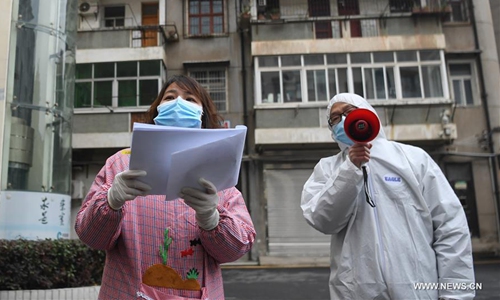HOME >> CHINA,SPECIAL-COVERAGE
Viral transmission via aerosol not verified: NHC
By Deng Xiaoci Source:Global Times Published: 2020/2/9 21:43:40

Community workers learn about residents' situation in Caidian District of Wuhan, central China's Hubei Province, Feb. 7, 2020. Wuhan, the epicenter of the novel coronavirus outbreak, is combing communities to ensure every confirmed or suspected patient is located and attended to. (Xinhua/Cheng Min)
Chinese health authorities clarified on Sunday that the transmission routes of the novel coronavirus via aerosol and oral-fecal are yet to be verified, reiterating that the main routes of the virus infection remain transmission via contact and direct transmission such as transmission via respiratory droplets.
The clarification was made public in a Sunday article posted by the National Health Commission (NHC) on its official Sina Weibo account after Zeng Qun, deputy head of the Shanghai Civil Affairs Bureau, said at a Saturday press conference that the novel coronavirus can transmit via aerosol.
The news about the possibility of the coronavirus transmission route via aerosol generated heated discussion online, worrying many who fear that the airborne virus could spread further and get them infected.
"If the virus can hide itself in the air, we dare not open our windows anymore," some commented.
In the Sunday post, the NHC clarified that the aerosol transmission refers to the nucleus composed of proteins and pathogens that came out from the droplets upon evaporation, which further float in the air in the form of aerosol, possibly causing long-distance transport.
The NHC also said that normally, there would not be any novel coronavirus in the air if sufficiently ventilated, and also suggested that the public should open their windows at least twice a day as an effective measure to lower the chance of infection.
However, without enough ventilation, for example in narrow spaces such as the inside of a car or office, aerosol transmission should be also considered, said Yao Maosheng, a bioaerosol study expert and professor from the College of Environmental Sciences and Engineering of the Peking University in Beijing.
Yao told the Global Times on Sunday that even breathing in viruses does not necessarily mean that one would surely get infected, as it would be determined by factors such as the number of live virus and the virus's own infection characteristics.
The NHC stressed that the transmission of the virus via aerosol can only take place under certain conditions, such as in the professional medical operation process of tracheal intubation. It added that wearing masks in the correct way is one of the best measures to prevent ordinary people from getting infected by the virus.
In open spaces, the chance of getting infected can be almost negligible, if not closely surrounded by an infected patient, Yao said, when asked to comment on the possibility of infection through aerosol transmission.
Posted in: SOCIETY,FEATURE